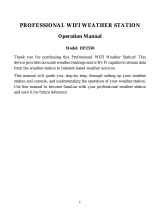
to prevent pinching or stretching tubing.
Free passage of air through both tubes is
vital for accurate readings.
4. Mount the Mark II Indicator loosely with
top screw. Center the bubble in spirit level,
then install bottom screw. Tighten the
screws keeping the level bubble centered.
5. Back the zero set knob all the way out,
then turn back in three full turns. Remove
reservoir “fill” plug and carefully fill indicator
until red gage fluid rises to “zero” mark on
scale. Use zero set knob for final adjustment
then replace fill plug. Should you overfill,
fluid may be removed by using a pipe clean-
er to absorb excess fluid in the reservoir.
6. Cut off excess connecting tubing, sepa-
rate the tubes slightly, and slip the red
striped tube over left connector at top of
instrument (above fill plug). Plain tube is
similarly connected to right (or more cen-
tered) connector. The Wind Speed Indicator
should now be in operation. If tube connec-
tions are reversed, a negative indication will
result.
MAINTENANCE
1. Periodically, disconnect the tubing from
the indicator and adjust fluid level to zero
mark. Add fluid if necessary, but do not use
substitutes. Indicator may be wiped off with
damp cloth as necessary.
2. Occasionally check weather vane (Part
No. 162). It should rotate freely. Pull up to
clean out spider nests, dirt, etc. Openings to
tubing connections in body should be clear
and free of any restriction.
3. Gently, but firmly pull out the static plate
assembly (Part No. 164). Check drain hole
to make certain it is open. If necessary,
clean entire plastic roof top assembly in
soap and water with soft brush or pipe
cleaner. When reassembling static plate and
weather vane, make certain they are pushed
back firmly to prevent their coming apart in
service.
4. Check connecting tubing (Part No. 290). It
must not be kinked or flattened at any point.
Cut or worn through spots will cause leaks
and destroy the accuracy of the instrument.
Such leaks must be repaired or the entire
tubing replaced.
5. Rainwater or indicator fluid may occa-
sionally enter the tubing and will cause erro-
neous readings. The drain system in the roof
top pick up unit has been carefully designed
to expel rainwater in normal quantities.
Presence of water in the connecting tubing
indicates that the drain system is plugged
and should be cleaned or that the pick up
unit is mounted in a location where air flow
is upward (such as too close to a peaked
roof) so that rainwater remains airborne in
excessive quantities.
Gage fluid in the tubing indicates low fluid
level, improper zero adjustment or wind
gusts in excess of 90 MPH (145 KPH). It
may be difficult or impossible to remove this
liquid. Test for presence of obstruction or
water in tubing on a day with no wind.
Remove tubing connections from the gage,
adjust zero set, blow gently into one tube at
a time and attach to gage quickly. If reading
does not stay at zero, there is fluid in the
tubing. To correct, hang tubing vertically
from center with ends down for several
days. Reconnect and retest. If condition
persists, the tubing should be replaced.
CAUTION:
Do not blow into gage or weather vane!
Gage fluid may be forced out of the oppo-
site indicator connection into the tubing or
onto your wall or carpet causing difficult to
remove oil spots and stains.
NOTE:
Heavy wind driven snow will sometimes
enter pick up and temporarily affect read-
ings until it thaws or evaporates.
page 2









